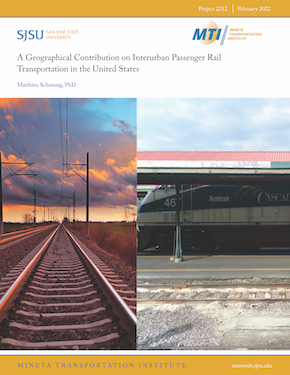- 408-924-7560
- mineta-institute@sjsu.edu
- Donate
A Geographical Contribution on Interurban Passenger Rail Transportation in the United States
Why does the rail infrastructure of the United States lag behind those of many other developed countries? Where is U.S. high-speed rail? This research approaches this in a dilemma by exploring Amtrak’s traditional rail services and high-speed rail projects in the nation to understand the workings of public rail transportation policies, what they contain, and how they are developed and pursued by the different stakeholders. This research utilizes case studies and a multiscale approach to analyze the territorialization of intercity rail transportation policies. The analysis demonstrates the emergence of a bottom-up approach to projects, notably apparent in the California HSR project and in the modernization of the Cascades corridor. Furthermore, this research concluded that, first, the development of uniform arguments and recommendations to encourage new rail policies emphasizes structuring effects and economic role of high-speed rail, congestion reduction, modal shift. Second, a tangible though uneven pro-rail position exists among public actors at all levels. Stakeholders prioritize improving and modernizing existing corridors for the launch of higher-speed services, and then on hybrid networks that combine different types of infrastructures. Although there are no publicly backed projects for new lines exclusively dedicated to high-speed rail, most of the high-speed corridors are in fact “higher-speed” corridors, some of which are intended to become high-speed at some time in the future.
MATTHIEU SCHORUNG
Matthieu Schorung has a PhD in Transport Geography and Urban Planning (University of Paris-Est, France, 2019). His PhD dissertation, defended in July 2019, is entitled: “Passenger Rail Transport in the United States between institutional conflicts, territorialization process and urban anchorage”. His work focuses on sustainable transport policies, specifically on conventional rail and high-speed rail, in the United States and in Europe (France mainly) and urban planning around nodal infrastructures (rail stations, transit-oriented development). During his doctoral research, he focused on three case studies: San Francisco Bay Area, Pacific Northwest (Cascadia Region) and South Florida. His first postdoctoral position (2019-2020) in the research chair Amenager le Grand Paris [Planning the Greater Paris] (University of Gustave Eiffel, France) under the supervision of Caroline Gallez (Research Director, University of Gustave Eiffel) focused on the development of station districts as part of the Grand Paris Express project and on planning practices, the interplay of actors and public action tools applied to transport, in particular the analysis of a new tool developed for this project (the pole committee). He is currently (since January 2021) a postdoctoral researcher in the research chair Logistics City (University of Gustave Eiffel, France), under the supervision of Laetitia Dablanc (Professor, University of Gustave Eiffel) working on warehousing location and logistics sprawl and on the spatial impacts of e-commerce in American and European cities. During 2022, he will develop two complementary research topics: 1) public regulation and local policies related to urban logistics; 2) the spatial impacts of food e-commerce, in particular dark stores and dark kitchens.
-
Contact Us
San José State University One Washington Square, San Jose, CA 95192 Phone: 408-924-7560 Email: mineta-institute@sjsu.edu






